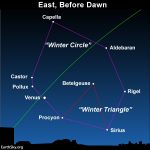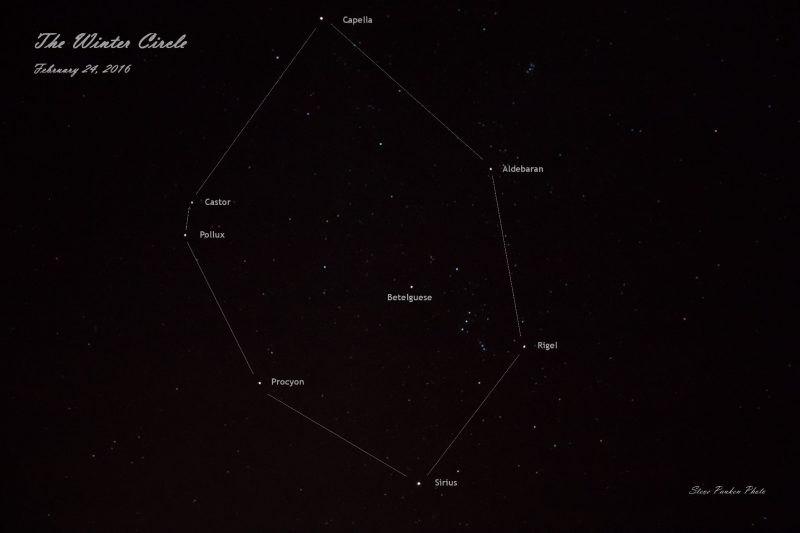
Although it’s summer in the Northern Hemisphere, a major sign of winter now looms large in the predawn/dawn sky. The dazzling planet Venus beams in front of the great big lasso of stars known as the Winter Circle. For the next several days, Venus shines at the eastern border of the Winter Circle, midway between the Procyon, the Little Dog Star, and the Gemini stars, Castor and Pollux.
The Winter Circle (sometimes called the Winter Hexagon) is an asterism – a star pattern that is not a recognized constellation. This humongous star formation consists of six 1st-magnitude stars in six different constellations.
Capella of the constellation Auriga the charioteer
Pollux of the constellation Gemini the Twins
Procyon of the constellation Canis Minor the Smaller Dog
Sirius of the constellation Canis Major the Big Dog
Rigel of the constellation Orion the Hunter
Aldebaran in the constellation Taurus the BullThe star Castor in the constellation Gemini, although not a 1st-magnitude star, counts as the sky’s brightest 2nd-magnitude star.
By the way, are you familiar with the constellation Orion the Hunter? The Winter Circle even dwarfs the Mighty Hunter, which only makes up the southwest (lower right) portion of the Winter Circle. If you’ve never seen the Winter Circle, but are acquainted with Orion, this constellation presents a great jumping off place for circumnavigating this brilliant circle of stars. Best of all, these stars are so bright that the’re even visible in the morning twilight.

Steve Pauken captured the Winter Circle on February 24, 2016, and wrote: “After seeing an illustration in EarthSky, I went out the back door to look for it. It was directly overhead, so I put my camera on the tripod, aimed straight up, and captured the image after a few tweaks for focus.”
The Winter Circle is so named because we in the Northern Hemisphere see this star formation on winter evenings. The Winter Circle is also visible from the Southern Hemisphere, though on their summer evenings.
The green line on the feature sky chart at top depicts the ecliptic, the Earth’s orbital plane projected onto the sky. The ecliptic can also be regarded as the sun’s apparent yearly pathway in front of the constellations of the zodiac. If you could see the stars in the daytime, you’d see the sun directly north of the star Aldebaran around June 1. Thereafter, the sun stays in front of the Winter Circle for about 1 1/2 months. Then the sun passes to the south (below) the Gemini stars, Castor and Pollux, in mid-July (about where you see Venus in late August/early September 2020).
We don’t see the Winter Circle in June and July because it’s lost in the glare of the sun. In late August, the Winter Circle returns to the morning sky. But we still won’t see the Winter Circle in the evening sky for months to come.
Aldebaran is out all night long, from dusk till dawn, around December 1; and the Gemini stars, Castor and Pollux, are out all night long, from dusk till dawn, around mid-January. Hence, we in the Northern Hemisphere associate the Winter Circle with short days and long nights, when these brilliant stars light up the dark months of the year.
Bottom line: These next few days, before daybreak, let Venus, the third-brightest celestial body, after the sun and moon, respectively, serve as your guide to the majestic Winter Circle.
from EarthSky https://ift.tt/3lpZXMO

Although it’s summer in the Northern Hemisphere, a major sign of winter now looms large in the predawn/dawn sky. The dazzling planet Venus beams in front of the great big lasso of stars known as the Winter Circle. For the next several days, Venus shines at the eastern border of the Winter Circle, midway between the Procyon, the Little Dog Star, and the Gemini stars, Castor and Pollux.
The Winter Circle (sometimes called the Winter Hexagon) is an asterism – a star pattern that is not a recognized constellation. This humongous star formation consists of six 1st-magnitude stars in six different constellations.
Capella of the constellation Auriga the charioteer
Pollux of the constellation Gemini the Twins
Procyon of the constellation Canis Minor the Smaller Dog
Sirius of the constellation Canis Major the Big Dog
Rigel of the constellation Orion the Hunter
Aldebaran in the constellation Taurus the BullThe star Castor in the constellation Gemini, although not a 1st-magnitude star, counts as the sky’s brightest 2nd-magnitude star.
By the way, are you familiar with the constellation Orion the Hunter? The Winter Circle even dwarfs the Mighty Hunter, which only makes up the southwest (lower right) portion of the Winter Circle. If you’ve never seen the Winter Circle, but are acquainted with Orion, this constellation presents a great jumping off place for circumnavigating this brilliant circle of stars. Best of all, these stars are so bright that the’re even visible in the morning twilight.

Steve Pauken captured the Winter Circle on February 24, 2016, and wrote: “After seeing an illustration in EarthSky, I went out the back door to look for it. It was directly overhead, so I put my camera on the tripod, aimed straight up, and captured the image after a few tweaks for focus.”
The Winter Circle is so named because we in the Northern Hemisphere see this star formation on winter evenings. The Winter Circle is also visible from the Southern Hemisphere, though on their summer evenings.
The green line on the feature sky chart at top depicts the ecliptic, the Earth’s orbital plane projected onto the sky. The ecliptic can also be regarded as the sun’s apparent yearly pathway in front of the constellations of the zodiac. If you could see the stars in the daytime, you’d see the sun directly north of the star Aldebaran around June 1. Thereafter, the sun stays in front of the Winter Circle for about 1 1/2 months. Then the sun passes to the south (below) the Gemini stars, Castor and Pollux, in mid-July (about where you see Venus in late August/early September 2020).
We don’t see the Winter Circle in June and July because it’s lost in the glare of the sun. In late August, the Winter Circle returns to the morning sky. But we still won’t see the Winter Circle in the evening sky for months to come.
Aldebaran is out all night long, from dusk till dawn, around December 1; and the Gemini stars, Castor and Pollux, are out all night long, from dusk till dawn, around mid-January. Hence, we in the Northern Hemisphere associate the Winter Circle with short days and long nights, when these brilliant stars light up the dark months of the year.
Bottom line: These next few days, before daybreak, let Venus, the third-brightest celestial body, after the sun and moon, respectively, serve as your guide to the majestic Winter Circle.
from EarthSky https://ift.tt/3lpZXMO

Aucun commentaire:
Enregistrer un commentaire